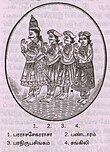
Back سلالة آريا كاكرافارتي Arabic আর্য চক্রবর্তী রাজবংশ Bengali/Bangla Aryacakravarti Catalan Ârya Chakravarti French आर्यचक्रवर्ती राजवंश Hindi Dinasti Aryacakrawarti ID Dinastia Aryacakravarti Portuguese ආර්යචක්රවර්තී රාජවංශය Singhalese ஆரியச் சக்கரவர்த்திகள் Tamil
| Arya Chakravarti | |
|---|---|
 | |
| Country | Sri Lanka |
| Founded | 1277 CE |
| Founder | Kulasekara Cinkaiariyan |
| Final ruler | Cankili II in Jaffna Kingdom |
| Titles | Cinkaiariyan, Cetukavalan, Kangkaiariyarkoon |
| Estate(s) | Jaffna Kingdom |
| Dissolution | 1619 |
| Cadet branches | None |
The Arya Chakravarti dynasty (Tamil: ஆரியச் சக்கரவர்த்திகள் வம்சம், Sinhalese: ආර්ය චක්රවර්තී රාජවංශය) were kings of the Jaffna Kingdom in Sri Lanka. The earliest Sri Lankan sources, between 1277 and 1283, mention a military leader of this name as a minister in the services of the Pandyan Empire; he raided the western Sri Lankan coast and took the politically significant relic of the Buddha's tooth from the Sinhalese capital city of Yapahuwa. Political and military leaders of the same family name left a number of inscriptions in the modern-day Tamil Nadu state, with dates ranging from 1272 to 1305, during the late Pandyan Empire. According to contemporary native literature, such as Cekaracecekaramalai, the family also claimed lineage from the Tamil Brahmins of the prominent Hindu pilgrimage temple of Rameswaram in the modern Ramanathapuram District of India.[1] They ruled the Jaffna kingdom from the 13th until the 17th century, when the last of the dynasty, Cankili II, was ousted by the Portuguese.